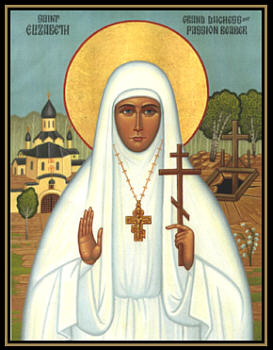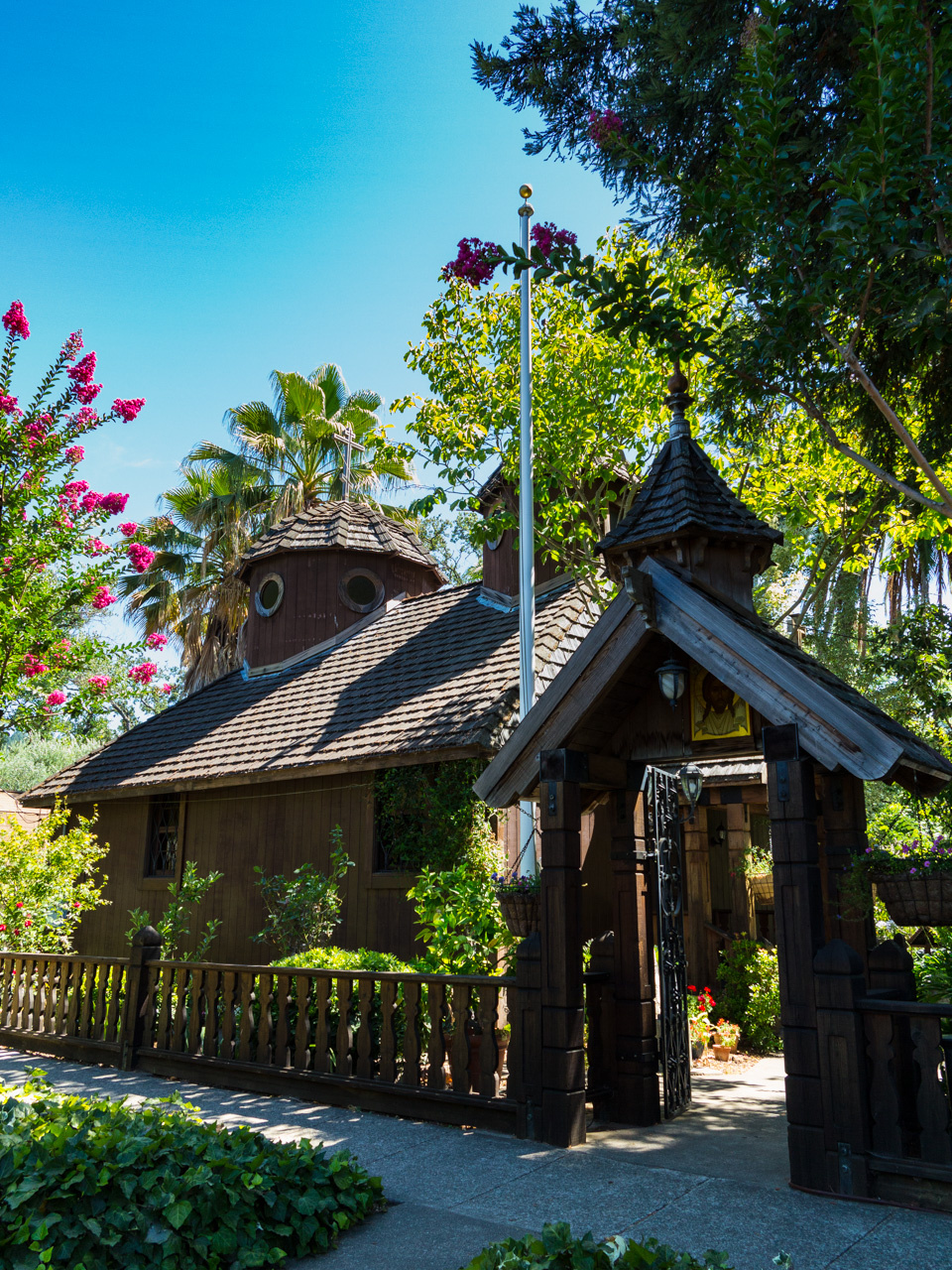Life of Prayer and Worship
at the Church of Our Lady of the Angels
We are
a religious house of
the Russian Orthodox Church Outside Russia,
who fled
Russia in 1922 principally to the English-speaking world.
We follow
the calendar of the Russian Orthodox Communion, second largest communion of Christians on earth.
In this we follow the
the Julian Calendar
and administer her sacred mysteries.
This means that our lives are lived in the same calendar that governed the lifeworld
of the Lord Jesus
and
which the English-speaking Church used until the mid-eighteenth century.
We offer the prayers of Matins, Eucharistic worship, and Vespers each day
other than Wednesdays and Fridays.
Our Divine Liturgy has been that of St. Germanus of Paris,
which is the only Western Liturgy to be approved by the Holy Synod of the Russian Orthodox Church
and
by the Patriarch of Moscow and All Russia.
Closer to home,
our Liturgy was blessed by St. John of Shanghai and San Francisco (our Diocese),
who served it himself.
Recently, we have begun to serve Eastern Rite liturgies.

We are deeply humbled
that our Altar is a burying "ground"
(by virtue of their relics)
for
St. Dionysius the Areopagite;
Pope St. Fabian;
St. Elisabeth the New Martyr;
St. Tikhon, Patriarch of Moscow;
and
several saints of the Latin West:
St. Dominic (founder of the Dominican Order);
St. Thomas Aquinas (a doctor of the Roman Church);
St. Rose of Lima (Roman Catholic patroness of the Americas).
We are also humbled to be a sanctuary for a second-class
relic of St. Anne, Holy Mother of the Most Holy Theotokos.
The Russian saints speak powerfully into our situation at this
sad point in our own history and cultural decline.
Their story is one of furious atheists who suppressed the faith
and
destroyed places of worship all over the newly conceived Soviet Union.
In 1937 and 1938 alone 200,000 members of the clergy were executed.
St. Elisabeth,
a Lutheran granddaughter of Queen Victoria,
sold all that she had following her husband's death,
entered religious life as an Orthodox nun,
and
established the Martha and Mary Home to give succor to orphans and the poor of Moscow,
which eventually would house the Sisters of Love and Mercy,
which she also founded.
Soon, she would be arrested along with her fellows.
They were pushed into an abandoned mineshaft into which hand grenades were then thrown.
An eyewitness described her humility and meekness as she
sought to bandage others who were injured prior to her own violent death.
Hymns could be heard arising from the shaft.
Like St. Elisabeth the New Martyr, we are converts to Orthodoxy.
While our commitments to the original Catholic Church,
the Undivided Church of the first thousand years,
go back decades,
our conversion has opened new dimensions of spiritual insight.
 Our Community's longtime history has been mostly
Roman Catholic,
followed by a brief period as guests in an Anglo-Catholic diocese
whose historical roots were tied to St. Tikhon.
Our priest was ordained in the "Biretta Belt,"
the historical stronghold of Anglo-Catholicism
in the Episcopal Church
and
served the Roman Catholic Church for ten years.
Our Community's longtime history has been mostly
Roman Catholic,
followed by a brief period as guests in an Anglo-Catholic diocese
whose historical roots were tied to St. Tikhon.
Our priest was ordained in the "Biretta Belt,"
the historical stronghold of Anglo-Catholicism
in the Episcopal Church
and
served the Roman Catholic Church for ten years.
For Anglo-Catholicism has always been the "middle way" between West and East.
In the early twentieth century,
Anglican priests who converted to the Russian Orthodox Church
were simply "clothed" as Orthodox priests
and
their Orders received.
By contrast,
Roman Catholic priests who converted were asked to begin
with baptism and chrismation and then ordained.
The future Patriarch and Saint Tikhon
had become Bishop of the Aleutian Islands and North America
and
forged friendships with
the Anglo-Catholic bishops of the Great Lakes area,
where our Hermitage priest was first ordained.
(For the record,
he requested baptism and chrismation prior to his
ordination to Minor Orders.)
Yet,
following the Great Schism,
the Western Church departed radically from the East in its ecclesial structure,
social norms,
and
theological beliefs.
In the area of the Atonement,
which for a thousand years had focused on the
the life-giving energies of the Creator,
a new theory was proposed by an Italian monk named Anselmo.
His preoccupation was with death.
Consequently, a new, linear worship space was conceived in the West
with sight lines of tragedy converging at
a High Altar where the dead, limp body of the Lord Jesus was offered.

We reject this radical departure from historical Christian belief.
Our Eucharistic worship focuses upon the incommensurable
and
life-giving
Life of our Creator-God,
receiving the mindbending mystery that the One Who was offered
as a ransom for many (Mark 10:45)
turned out to be the Lord of Life,
shattered the House of Death,
and
indelibly enshrined Eternal Life into our broken world.
Our worship space is Orthodox:
non-linear
in its feel and character.
What is Orthodox worship like?
Imagine entering a Divine Liturgy
after worship has begun.
Soon you may wonder,
"Where is this place?
How did I get here?
I am not sure of the way out."
It seems to be circular,
but even that is not quite right.
At the door, one encounters holy icons inviting to greet and venerate "family,"
the Communion of Saints.
The saints welcome you into an experience not bounded by time or space.
They invite you into their love if your heart is right.
They offer to guide you along a path leading to holiness,
where they are.
Soon this mysterious place begins to fill with incense.
Bells are sounding from .... one knows not where.
Chanting is heard wafting through the air it seems from all directions.
Sacred ministers roam about (it seems) in no certain direction.
No one is seated.
In fact,
no geometry of chairs or groups can be discerned.
Geometry and logic have been suspended in this place beyond human reason.
Mystery and spiritual fellowship has supplanted it.
Even the boundaries separating this world and the greater life seem to have collapsed.
Soon the Most Beloved will appear.
He is among us!
We know that He loves all and each of us,
for that is His Nature.
How did this happen?
Where did He come from?
We do not know.
For a hidden place,
a secret place,
a mysterious place
was concealed by
the iconostasis,
which seemed no different than any other wall,
though this one is made of a great cloud of witnesses.
Withal, it is their embrace,
an
endlessly deep embrace,
which gives way to power and grace and intimacy of God.
Over time as you advance more deeply into that embrace,
you begin to wonder if this so-called church building is not something else,
like the stable surrounding the Christ child,
infinitely bigger on the inside than on the outside.
This is not a place where you sit and watch as an onlooker or a passerby.
There are no pews nor divisions among the people living and once-living,
among angels and saints.
This is a Divine space
which is part of you, and you are part of it.
It is a space built of living stones unto a spiritual temple
(1 Peter 2:5).
Our spiritual ideal for this place of mystery where we welcome
our Lord and God
and
where He stoops to grace us with His Presence
is the little, otherworldly castle set within the Cathedral of Christ the Savior in Moscow
(seen on our webpage "Jurisdiction").
The Royal Doors open,
and
He is there in our midst.
We have purchased a building site and lumber for the Church of Our Lady of the Angels.
This building will follow the pattern of
the monastery church
of
Holy Assumption Monastery
of the Orthodox Church in America,
subject to the approval of His Eminence Kyrill,
Archbishop of San Francisco and the Western American Diocese.
Meantime, our Altar
continues to be the
center of our humble lives of worship at Our Lady of the Angels Hermitage.
As befits our poverty, we worship in
a small space
with a kitchen to one side
and a storage area on the other
as we continue to live as refugees.
We see only the radiance of the saints and angels and archangels
and
all the company of Heaven.
We see the Gate of Heaven
and
are not distracted by lesser things.
Soon He is among us.
He gives us life,
and
He will receive our deaths.
Still, we labor day by day
steadily advancing to the glorious time when we shall
construct our Katholicon
(monastric church),
not as a building to welcome the world,
but as a place completely consecrated to God.
There we may set about the solemn work of praying
for those who have asked for our prayers
and
to intercede
with the angels and saints
for a world that is lost and in need of the light and grace.
We are monastics
living in silence and meditative worship.
We do not invite the world into this sacred space,
but we push the things of the world out beyond our fenced perimeter
that the Kingdom of God may live and breathe and have its Being.
Here, the ones who love God,
who have picked up their crosses and followed
Him with single-minded devotion,
may live His kind of life, in His Presence, without distraction.
Love not the world, neither the things that are in the world.
If any man love the world, the love of the Father is not in him.
(1 John 2:15)
|
Visitors we welcome by means of the Web
who may read our reflections
or
listen to our
Podcasts.
May God bless you and protect you as you continue your journey
in a diseased and infectious world.
His desire is that you come to to His sheepfold.
He will guide you.
There the sheep know His voice,
"yet they will by no means follow a stranger,
but will flee from him, for they do not know the voice of strangers"
(Jn 10:5).
But the Good Shepherd you must seek with your whole heart.
He has little patience for the half-hearted.
There is no half-way with God (Rev 3:16).
Home

 Our Community's longtime history has been mostly
Roman Catholic,
followed by a brief period as guests in an Anglo-Catholic diocese
whose historical roots were tied to St. Tikhon.
Our priest was ordained in the "Biretta Belt,"
the historical stronghold of Anglo-Catholicism
in the Episcopal Church
and
served the Roman Catholic Church for ten years.
Our Community's longtime history has been mostly
Roman Catholic,
followed by a brief period as guests in an Anglo-Catholic diocese
whose historical roots were tied to St. Tikhon.
Our priest was ordained in the "Biretta Belt,"
the historical stronghold of Anglo-Catholicism
in the Episcopal Church
and
served the Roman Catholic Church for ten years.
